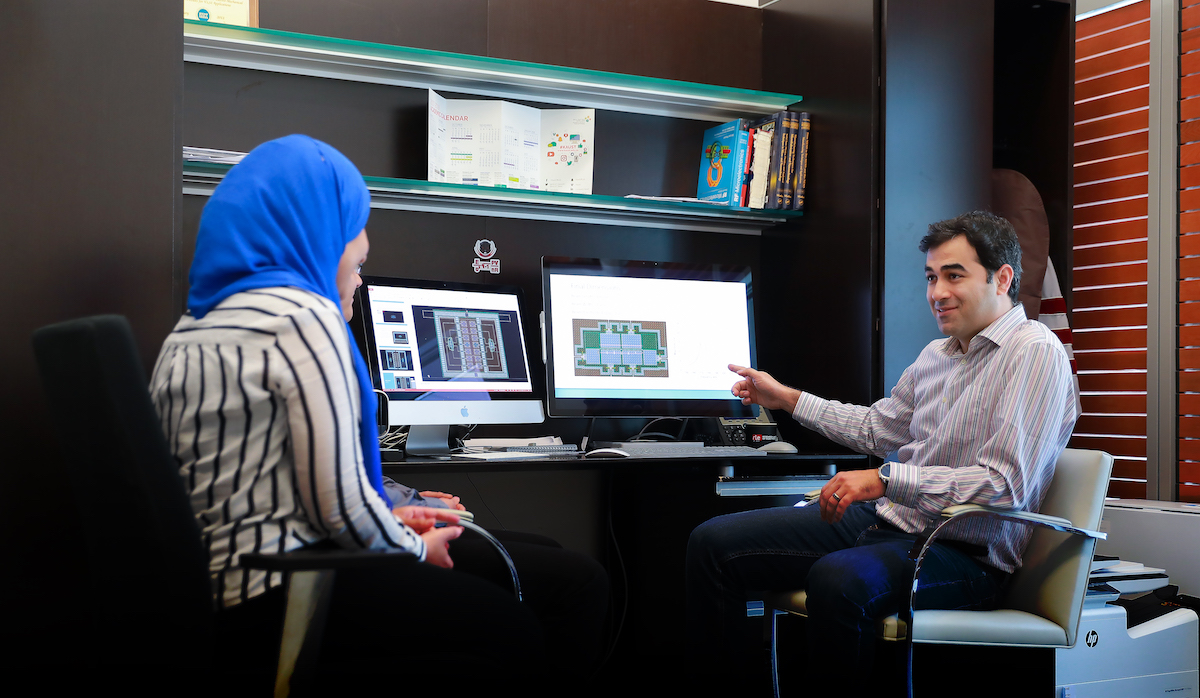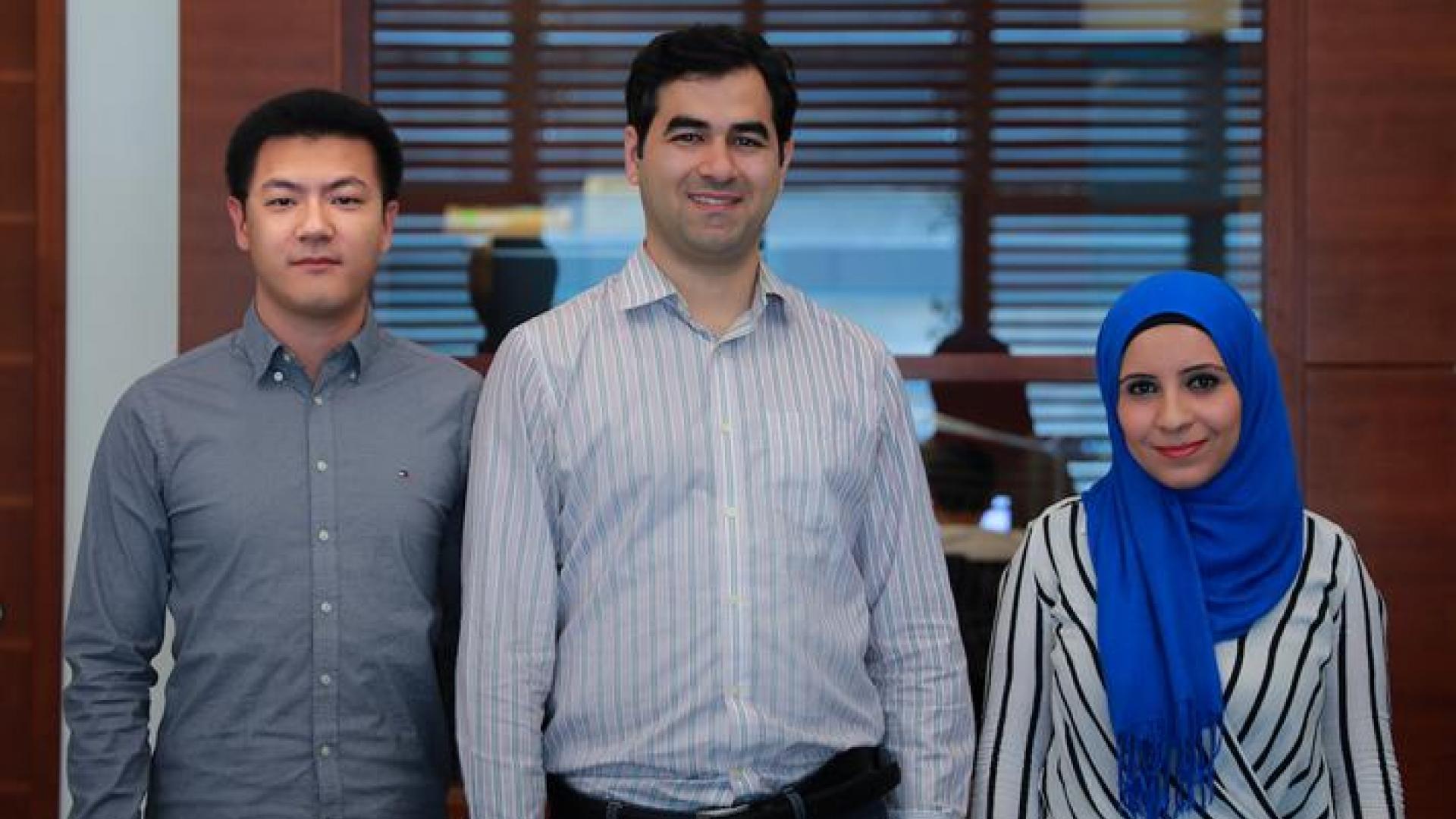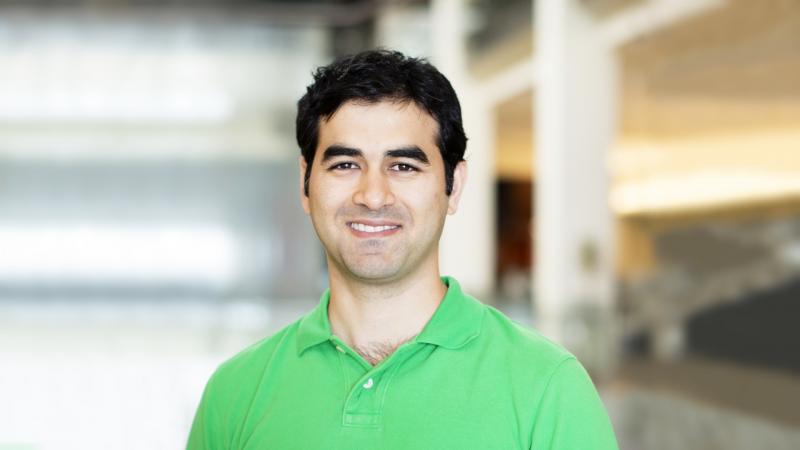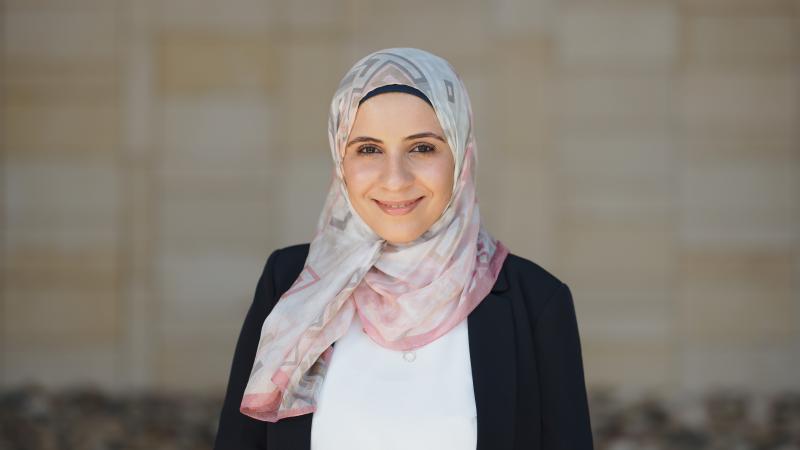By Sonia Turosienski
The city of the future will be innervated with millions of microscopic sensors. These sensors will need to be virtually invisible, extremely low power and, conversely, extremely powerful from a computing perspective. A team at KAUST is chasing this impossible list of requirements in the form of miniaturized mechanical structures or MEMS.
MEMS devices can be used for building various sensors and actuators. In particular, micro-resonators used in frequency filtering, bio and gas sensing, pressure sensing, acceleration detection and many other applications. In recent years, MEMS devices have also been used as the building blocks of energy-efficient electromechanical microcomputers.
Since the beginning of 2017, Hossein Fariborzi, KAUST assistant professor of electrical engineering Ph.D. students Sally Ahmed and Ren Li and visiting student Xuecui Zou, who form part of the Integrated Circuits and Systems Group, have been competing in the international MEMS Design Contest organized by the Cadence Academic Network, X-FAB, Coventor and Reutlingen University. On May 8 at the final awards ceremony at CDNLive EMEA 2018 in Munich, the KAUST team won second place for their project entitled "MEMS Resonator for Oscillator, Tunable Filter and Re-Programmable Logic Applications."
Fariborzi and his team's device is designed to be used in large digital circuits and eventually microprocessors. The current device is an upgraded version of a previous device that was designed and fabricated at the KAUST Nanofabrication Core Lab in collaboration with Professor Mohammad Younis' group. One of the unique features of the device is that it is runtime-reprogrammable, meaning that the function of each device in the circuit can be changed during the operation.
"We can never change the fabricated hardware, but now we can tune the hardware with electrical control signals and make the same device do different tasks based on the requirements of the system," Fariborzi explained.
The KAUST team showed that two MEMS resonators could replace more than 20 transistors for certain applications, such as digital adders. This can dramatically reduce the complexity of digital circuits.
"The reduced complexity of microresonator-based digital circuits results in minimum device count, low power consumption, smaller chip area and lower manufacturing costs," said Fariborzi.
Mutual learning curve
The project has formed part of Ahmed's Ph.D. research for the past two years. It was an opportunity for Ahmed and the rest of the team to learn and apply new skills and programs such as MEMS+, a design software from Coventor aimed specifically at MEMS designers. In the second round of the competition in the spring of 2017, they were selected as one of the 10 semifinalists invited to travel to CDNLive 2017 in Germany in order to present their work in person and attend workshops.
The team's MEMS device was different from the other entries. Their design was the only one to propose a scalable, re-programmable device which could perform logic functions and can be combined with multiple other devices to form a circuit. In fact, the team's design even challenged the limits of some of the sponsor's software, helping the sponsors pinpoint where they can innovate and improve their tools.
"In our semi-final interview, the Coventor representatives commented on how much effort we put in and our efforts to emulate the final product as much as possible before fabrication," explained Li.

"If you're going to create something, either do it perfectly or don't do it at all," said Ahmed when asked about her approach to the design process.
Fariborzi and the team explained that they were surprised at how much cooperation and mutual learning took place between them and the contest sponsors.
"Our interests, and the interests of the contest and sponsors aligned so we could use their expertise to further our research. They also benefited from Sally's intelligence and hard work. It's been teamwork at KAUST and also with the sponsors of the competition," Fariborzi pointed out.
The contest was an opportunity for X-FAB, one of the leading foundries for advanced analog and mixed-signal semiconductor applications, as well as Coventor and Cadence, who offer computer-aided design tools, to build relationships in academia and test their product and process with the help of ongoing research projects.
"[The contest sponsors] are asking Sally if they can use her design and data to inform their next development," Fariborzi added. "The data that we get from our testing will help them build and improve their modeling and computer-aided design (CAD) tools."
From device to system
Once a MEMS device is designed, fabricated and characterized, it then needs to be combined with other devices to form a circuit which will then be integrated into a system, like a microprocessor.
"The leap from device-to-circuit-to-system is huge. Traditionally there has been a disconnection between device designers and circuit designers. It's important to show that a single device which works perfectly also performs well in a circuit. There's a risk of a device being forgotten after it is created in a lab somewhere because it was never picked up by a circuit designer. A similar disconnection exists between circuit and system designers. What's missing for MEMS is reliable simulation tools that can handle multiple MEMS devices, something that has been developed for transistors long ago," Fariborzi said. "This would be a major step toward successful integration of these devices in circuits, systems and applications".
"At the moment we are only at the gate level, so we need to do a circuit and system-level simulation, and this is what the contest can help us to achieve," Ahmed explained.

(From left to right:) Ren Li, Sally Ahmed and Hossein Fariborzi stand next to the computer-simulated rendering of their MEMS design "MEMS Resonator for Oscillator, Tunable Filter and Re-Programmable Logic Device Using Partial Electrodes." File photo.
Powering the future's smart cities
One of the challenges in the field of MEMS is the difficulty of fabricating the devices at a smaller scale. Even universities with top research facilities—like KAUST—are still not able to match the industry-level fabrication processes. In addition to the knowledge sharing benefit of the contest, the winning teams will also get the chance to have their scaled design fabricated by XFAB.
With the trend towards smaller and more powerful electronics, the industry is moving from MEMS to NEMS, nanoelectromechanical systems. Fariborzi observes that the shift to smaller and smaller devices, in addition to the well-known challenges of lithography, creates issues such as increased power density and heat.
"There's no question that the cities of future will be filled with millions and millions of smart sensors and electronic gadgets; devices that rely on batteries or energy harvesting modules with limited capacity. A change of direction and a radical move and toward implementation of ultra-low power, post-CMOS devices, circuits and systems is inevitable," he concluded.


